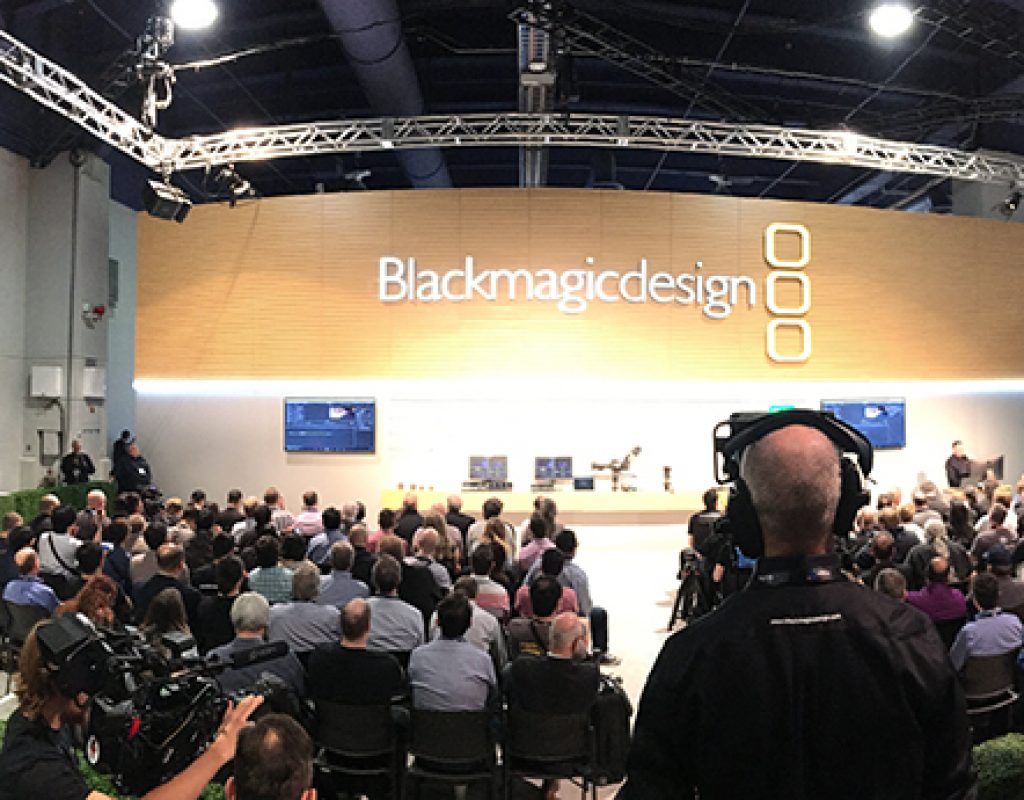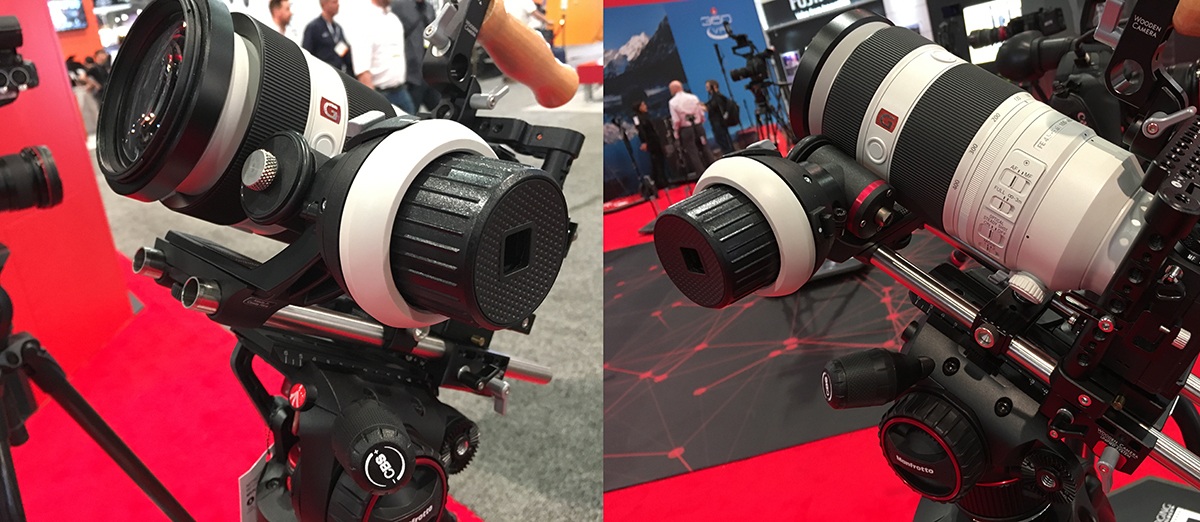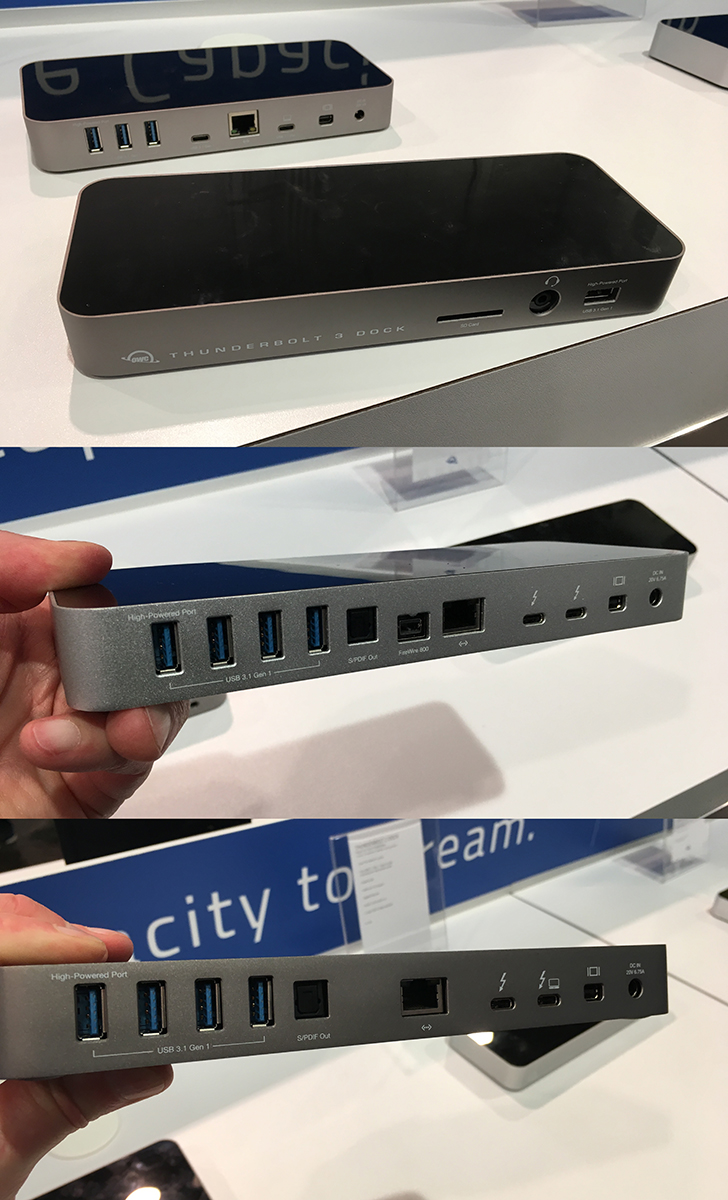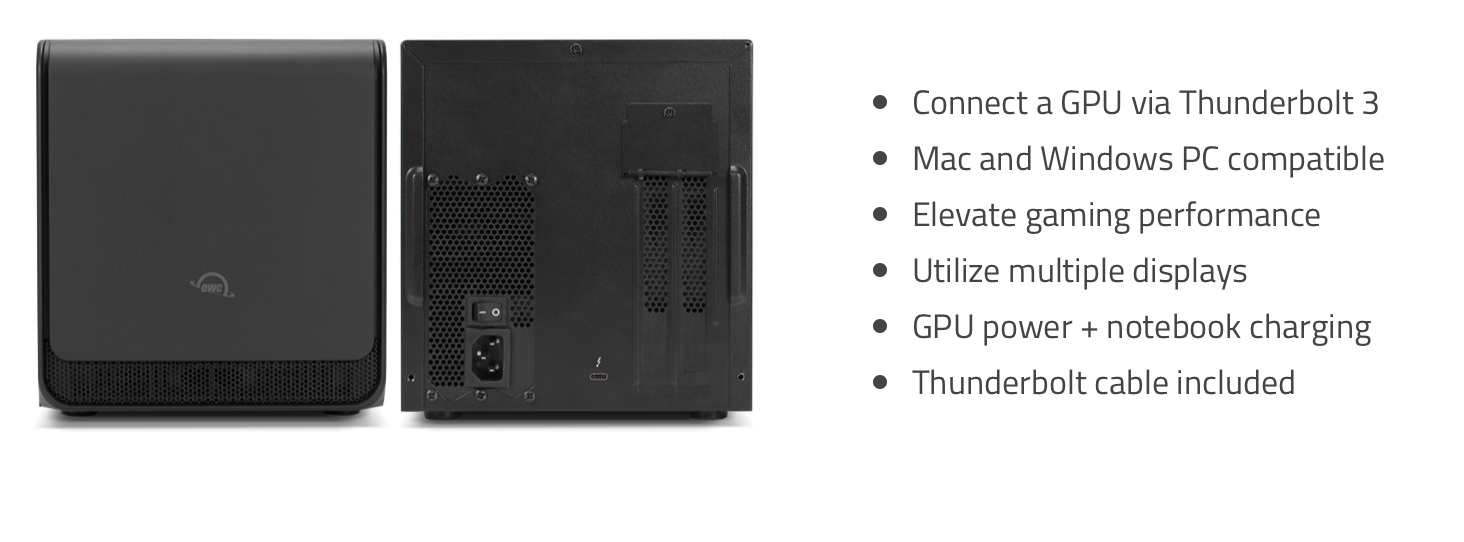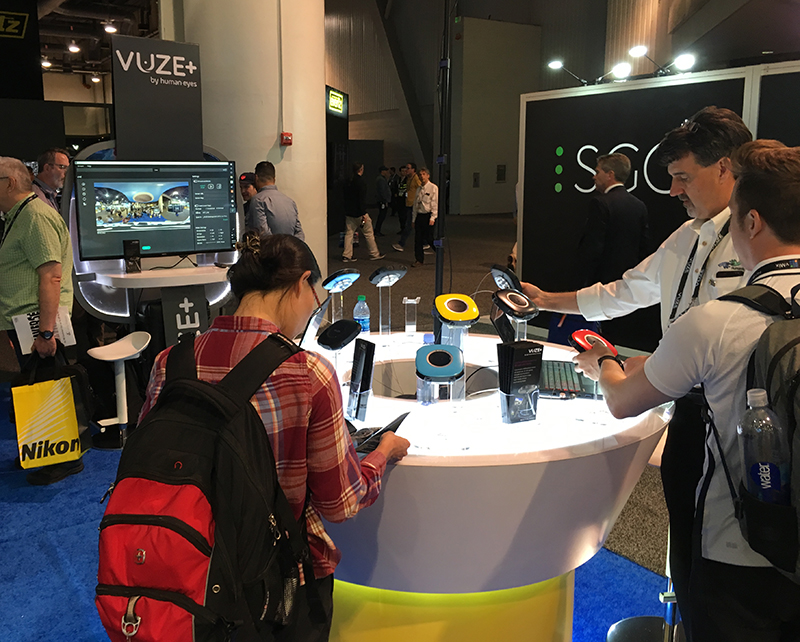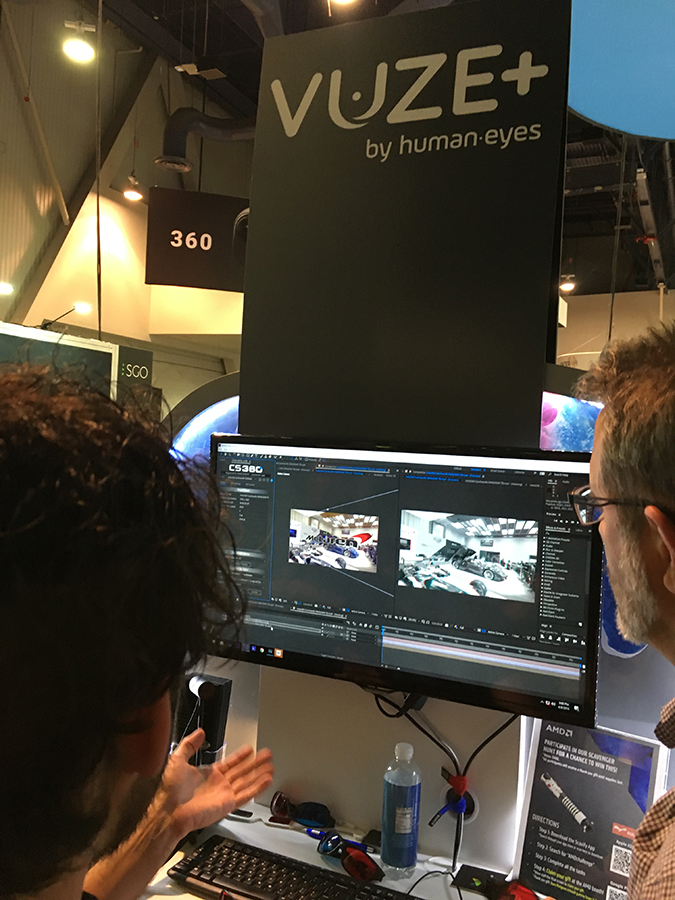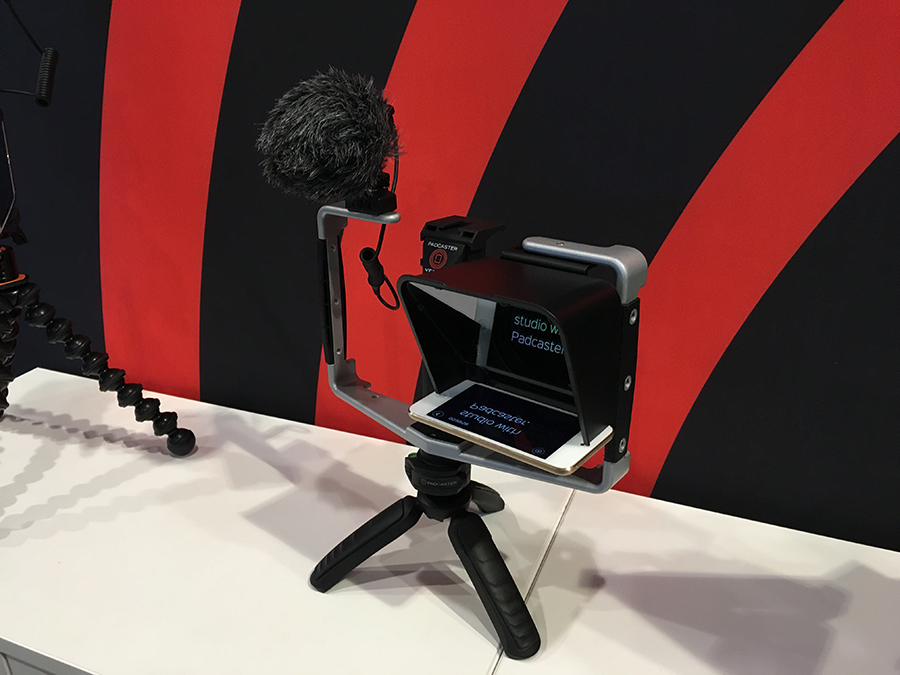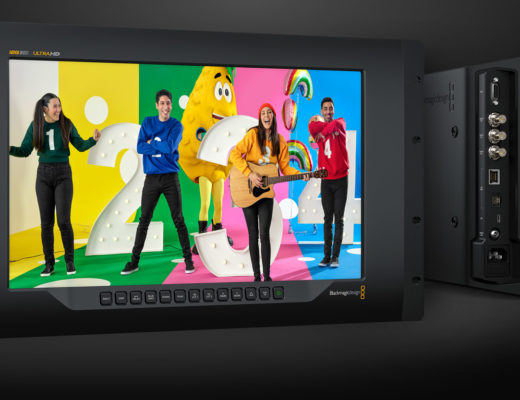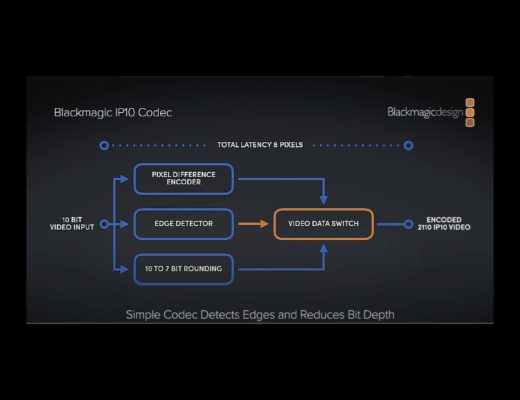This year I went to the NAB Show in Las Vegas with two things: (1) A knee injury, thus limiting my usual travel time all over the show floor, and (2) A well-scheduled itinerary to make sure I could see as much as I could and get specific exhibitors covered with my limited mobility. Bottom line is, I came away fully satisfied and excited by what I accomplished – and probably my best NAB Show ever!

This year I went to the NAB Show in Las Vegas with two things: (1) A knee injury, thus limiting my usual travel time all over the show floor, and (2) A well-scheduled itinerary to make sure I could see as much as I could and get specific exhibitors covered with my limited mobility. Bottom line is, I came away fully satisfied and excited by what I accomplished – and probably my best NAB Show ever!
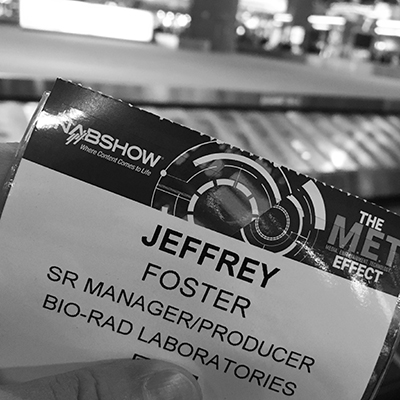
A side note about my attendance this year: not only have I produced videos, photography, workshops and other creative services for many different clients and industries over the years that I often write about here on PVC, but I also currently manage the Global MarCom Video & Imaging Services for Bio-Rad Laboratories Life Sciences. We produce a lot of video and animation content for marketing, customer service, education and internal corporate messaging, as well as product photography, compositing and other imaging related services. So this year, since I’m not acting as an instructor or trying to wear a hundred different hats at the show/conferences, I came with an agenda to research not only production gear and software solutions, but also explore a bit more into AI for production, as well as VR/AR technologies that we could implement in our marketing efforts at Bio-Rad.
So with that agenda and my discoveries, I’ll share with you MY experience at this year’s NAB Show by category:
Production Cameras
Blackmagic Design
The much-anticipated Blackmagic Pocket Cinema Camera 4K (PCC4K) was announced just before the show opened on Monday AM to a press conference behind their booth – along with a lot of other great updates to BM products and of course the DaVinci Resolve 15 software (will get into that later.)
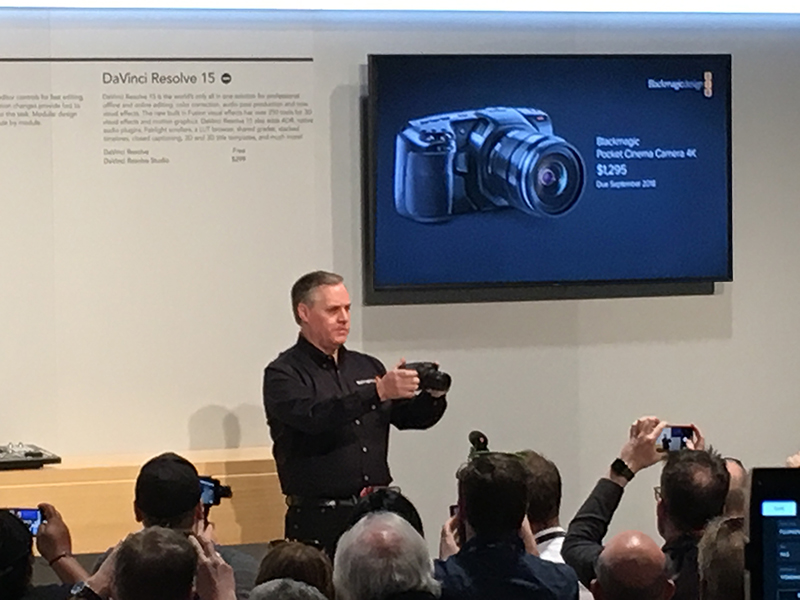
When the new PCC4K was unveiled at the event, you could hear a sea of “oohs” and shutter clicks. It’s totally different from what most folks presumed it might look like.
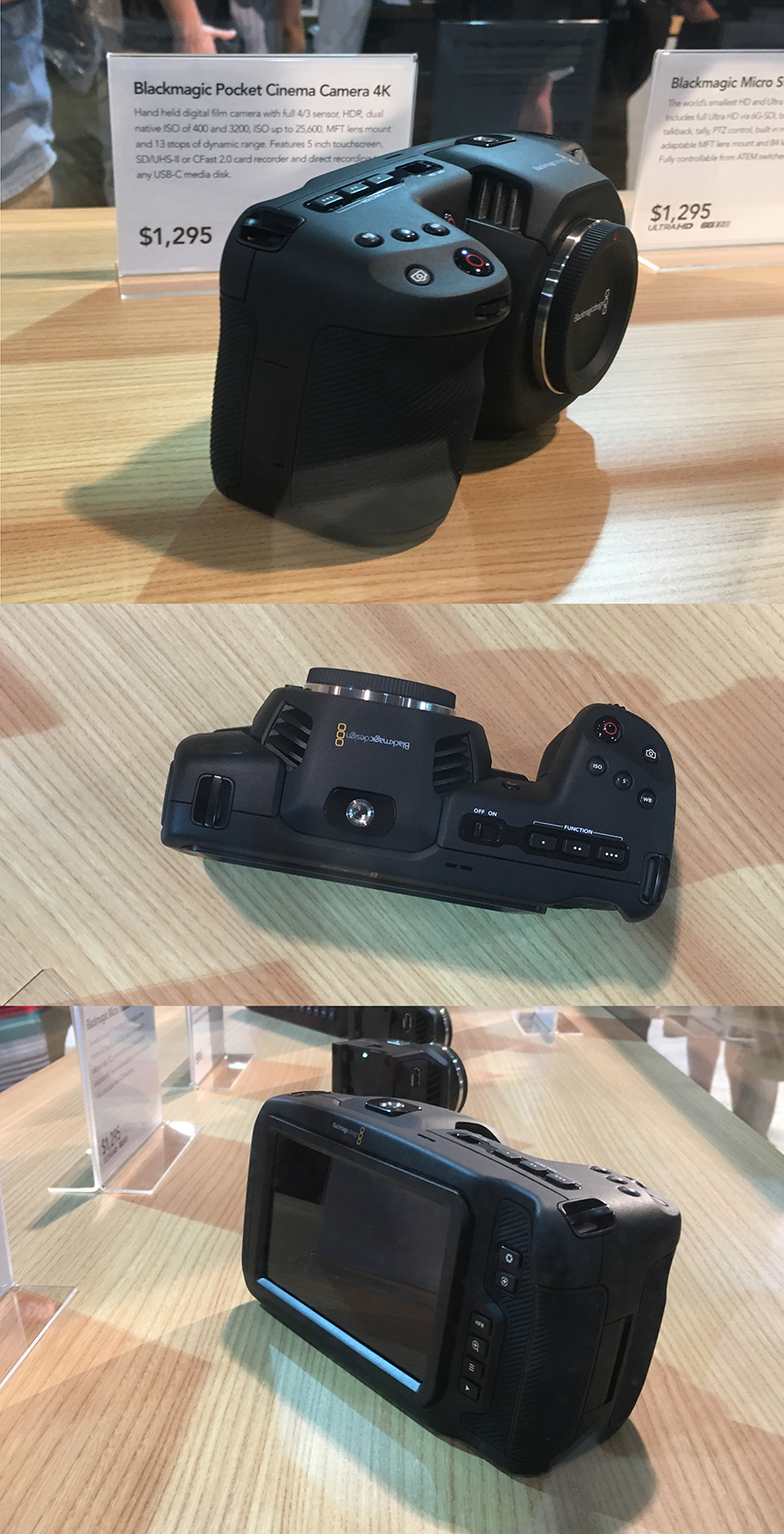
I think the most surprising thing about the camera was it’s size and form factor. No longer was it the approximate footprint of an iPhone as a true “pocket cam” but it’s now larger than most mirrorless cameras and smaller DSLR camera bodies.
The new Blackmagic Pocket Cinema Camera 4K has a full 4/3 HDR sensor, dual native ISO up to 25,600 with incredible low light performance and 13 stops of dynamic range. It features a unique USB-C Expansion Port, which allows customers to record using the internal SD/UHS-II and CFast recorders or directly to the same external disks you can use for editing and color correction.
The new design features a new lightweight carbon fiber polycarbonate composite material so the camera body has incredible strength and rigidity to protect it from accidental knocks and drops (although the prototypes at the show were milled from aluminum for significantly much more heft!). The handheld design features a multi function grip which has logically placed buttons and dials that allow super fast access to essential shooting functions such as recording start/stop, still photos, ISO, shutter, aperture, white balance, power and more.
The Blackmagic Pocket Cinema Camera 4K has an MFT lens mount, large 5 inch touchscreen monitor, 10-bit ProRes and 12-bit RAW recording, 3D LUTs, 4 built in microphones, mini XLR audio input with phantom power, Bluetooth wireless camera control, HDMI on set monitoring output and more.
We’re excited about the PCC4k as a great small-form companion to our URSA Mini 4.6K for B-roll and productions where a larger cine cam isn’t practical, but we want more than just DSLR footage.
While the new size and form of the PCC4K is anything but “pocket sized”, I’m definitely going to have my credit card ready for pre-orders in Sept when they announce a ship date! It will be available from Blackmagic Design resellers worldwide later this year for only $1,295.
Production Support Gear & Lighting
Fiilex
If you’ve been following my product reviews over the years, you’ll know that I’m a big fan of LED lighting – and Fiilex is at the top of my list for quality portable LED lights. They’re designed beautifully and their portable kits are extremely versatile both in the studio or on location and the P-series is always in my kit on any production.
Their new Matrix lights aren’t your typical multi-LED panel, but rather a high-intensity dense matrix LED cluster that provides a higher quality of smooth color-tunable light that can be easily shaped with their optional Fresnel lens and barn doors. This produces more even light where you want it and softer shadows and falloff. You won’t get the ramping effect of intensity when you adjust the color temp like you do with bi-color LED panels.

Even more impressive is their Q1000 production light. The Q1000 revolutionizes photo and video work by combining intense power, exceptional light quality, enhanced weather-resistance, and portable power options in one remarkable light. Maintaining the same color spectral versatility of the award-winning Q500, the Q1000 boasts a color tuning range of 2800-6500K. This stunning light is clean and accurate at all color temperatures, receiving outstanding TLCI (≥95) and CRI (≥93) ratings for its precise color rendition. The Q1000 also offers full dimming from 100% to 0% with no color spiking, as well as hue control of ±.25 Magenta/Green for deft hue correction on set.
They had it on the show floor with their new Fresnel spot and aimed it at the wall to show a comparison of spot shape, intensity and falloff on the edges. Truly remarkable how much control this light has!
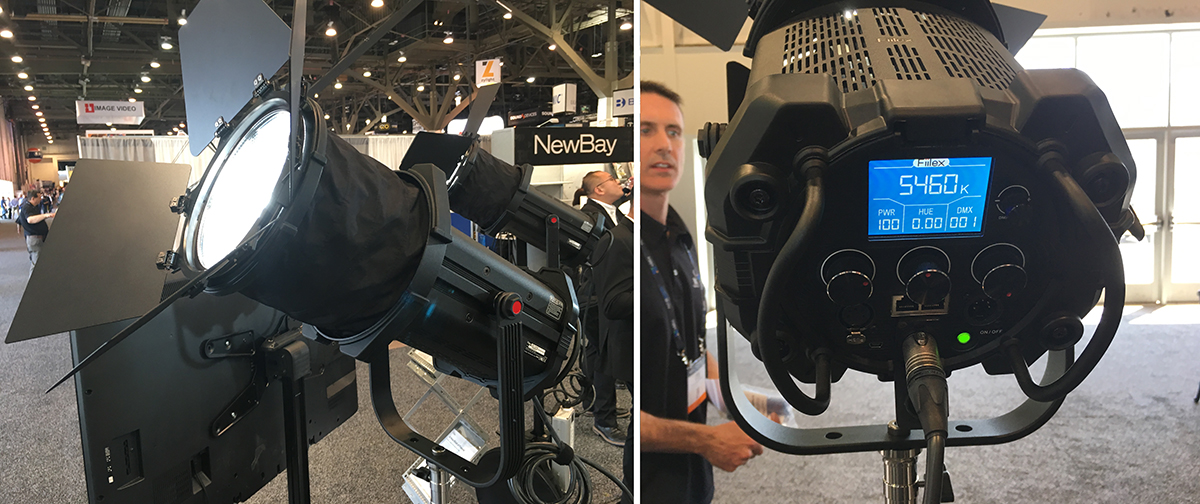
Weighing less than 13 lbs and featuring enhanced weather-resistance (IP-24), battery compatibility, and built-in DMX Control, the compact Q1000 can be easily rigged into any studio or used for on-location shoots.
Genustech
I love the quality of Genustech products. They feel well engineered and probably over-built for their price point. I’ve tested and reviewed several of their support gear products here on PVC over the years, but was really intrigued to find out they had a SIMPLE teleprompter solution that just makes sense.
Their new ScriptShade™ kit utilizes their already popular rail/mattebox system with a simple bracket and high-quality reflective mirror for your iPad Mini or smartphone tablet. If you’re like me, you often build out a rail/mattebox kit for various production setups and having to add a clunky teleprompter frame/bracket just makes for a clumsy (and heavy) setup. This is so simple and light that you can easily use this for a handheld camera as well as in the studio.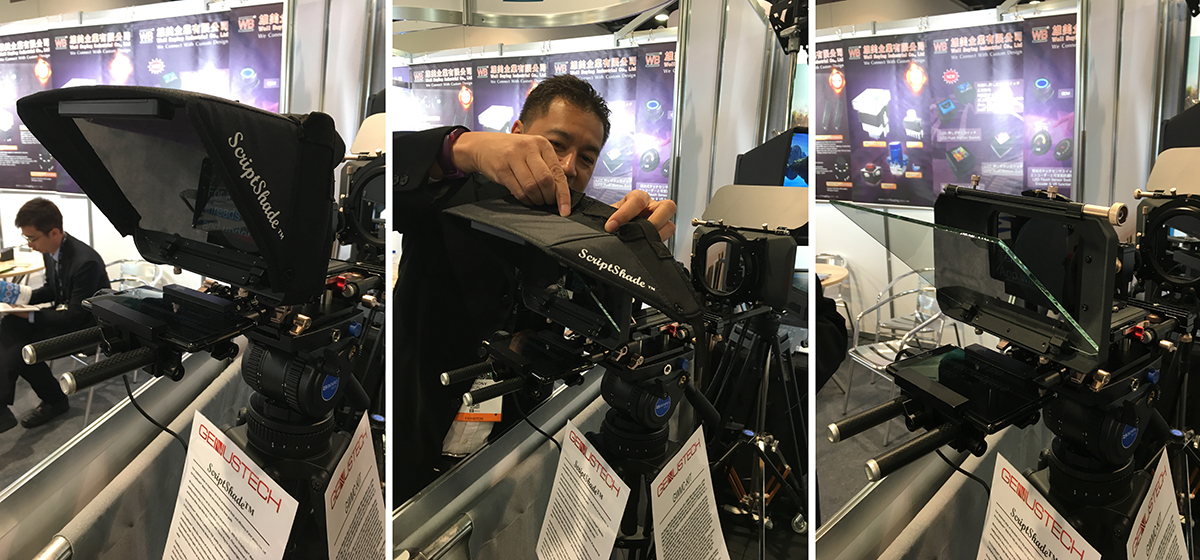
I will be getting a ScriptShade kit soon to test and review here on PVC this summer so stay tuned!
Manfrotto
I’ve been a Manfrotto/Bogen user since the late 80s when I bought my first Bogen 3236 photographers tripod with Bogen three-way head; which is still in use today and being all steel, heavy but hella stable on any surface!
At NAB this year I was able to stop by the booth and check out some of their more portable video tripods and gear. We use a Manfrotto 545GB for most of our general video production at work and it serves us well in most situations, and a Sachtler FSB-6 for our run & gun work.
But I was most impressed with their Manual Follow Focus for 15mm rods and the versatility it offers for various types of lenses. You can use it with cine primes and DSLR lenses without having to add a gear ring.
Editing Hardware & Software
AMD (Radeon Pro SSG)
I set up a meeting with the AMD product marketing folks at NAB to talk specifically about the Radeon Pro SSG graphics card for use in testing various 4K production hardware setups running Adobe CC. When I talked with them about the new Thunderbolt 3 external cases that both OWC and Akitio were showing at NAB this year, they got excited over the possibilities of my proposed workflow testing and suggested their new Radeon Pro SSG with onboard SSD for caching and rendering of complex sequences and layer-heavy composites.
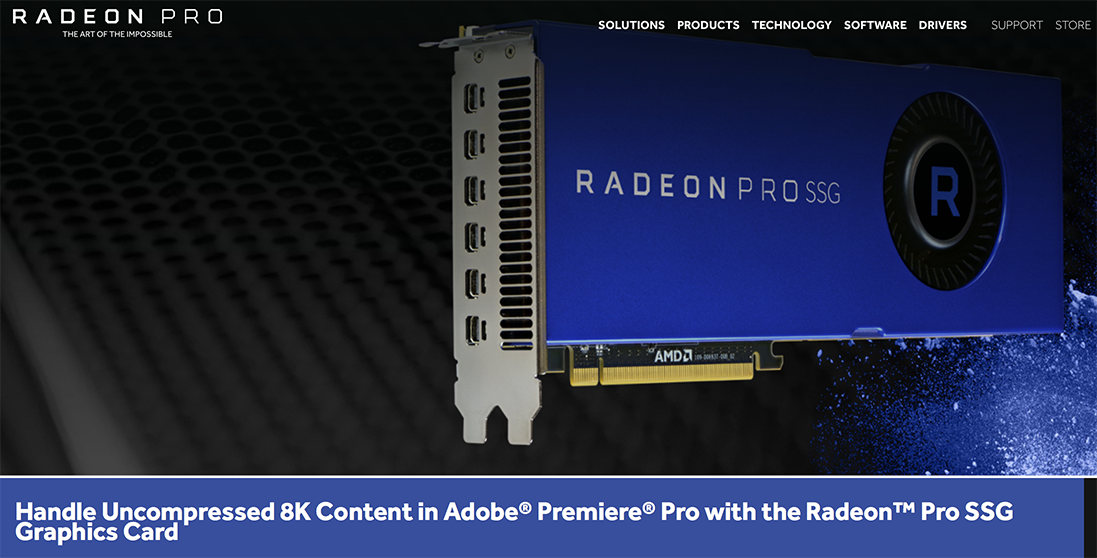
I’m currently testing a Lenovo Thinkstation P910 Benq 4K 32″ monitor, so I’m excited to see how this card can enhance both Adobe Premiere Pro and After Effects projects. Even from a Windows 10 laptop or MacBook Pro, we should find some enormous performance boosts. We will find out soon… read below!
OWC
I own probably more OWC external hard drives than any other brand for one reason. Well, two reasons, actually; they’re very affordable and they work. Reliable and rugged, I’ve put them up against G drives and many others, and I still have some of my old FW400 2GB 7200 drives working great today (backed-up, of course).
And when it comes to SSD drives, they’ve got a great lineup. I’ve been using their On-The-Go Pro 6G USB3 portable drive and have edited video directly off it on my MacBook Pro. I’ve also been using their Thunderbay 4 (4 x 250GB RAID) on Thunderbolt 2 for fast access 4K video editing which has been fantastic the past year or so.
This year, however, OWC has announced a few new Thunderbolt 3 products that I’m really excited to try out!
Like its predecessor, the Thunderbay 4 Thunderbolt 3 holds up to 4 individual 2.5″ SSDs or 2 3.5″ drives and uses OWC’s soft raid or RAID 5 ready. Super quiet operation and has two Thunderbolt 3 ports and an extra display port – plus you can daisy chain several Thunderbolt 3 devices and not affect your throughput.
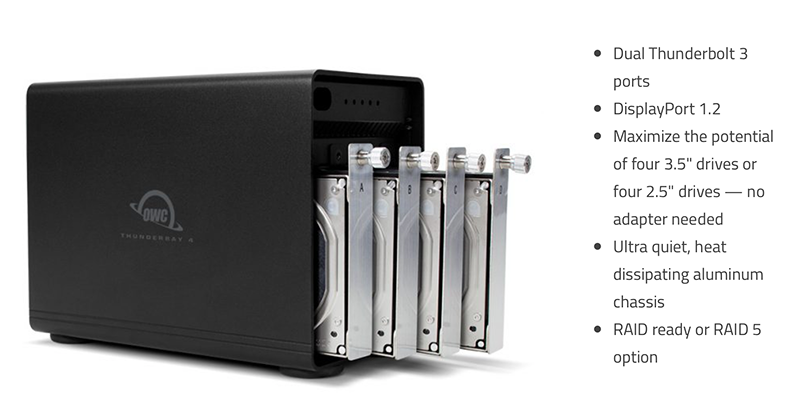
OWC’s newest portable is the ThunderBlade, completely solid state and no moving parts, with data transfer speeds up to 2800MB/s, 8TB capacity and the ability to daisy chain up to 6 Thunderbolt 3 devices. It comes in a ballistic hardshell case for ultimate portability and protection.
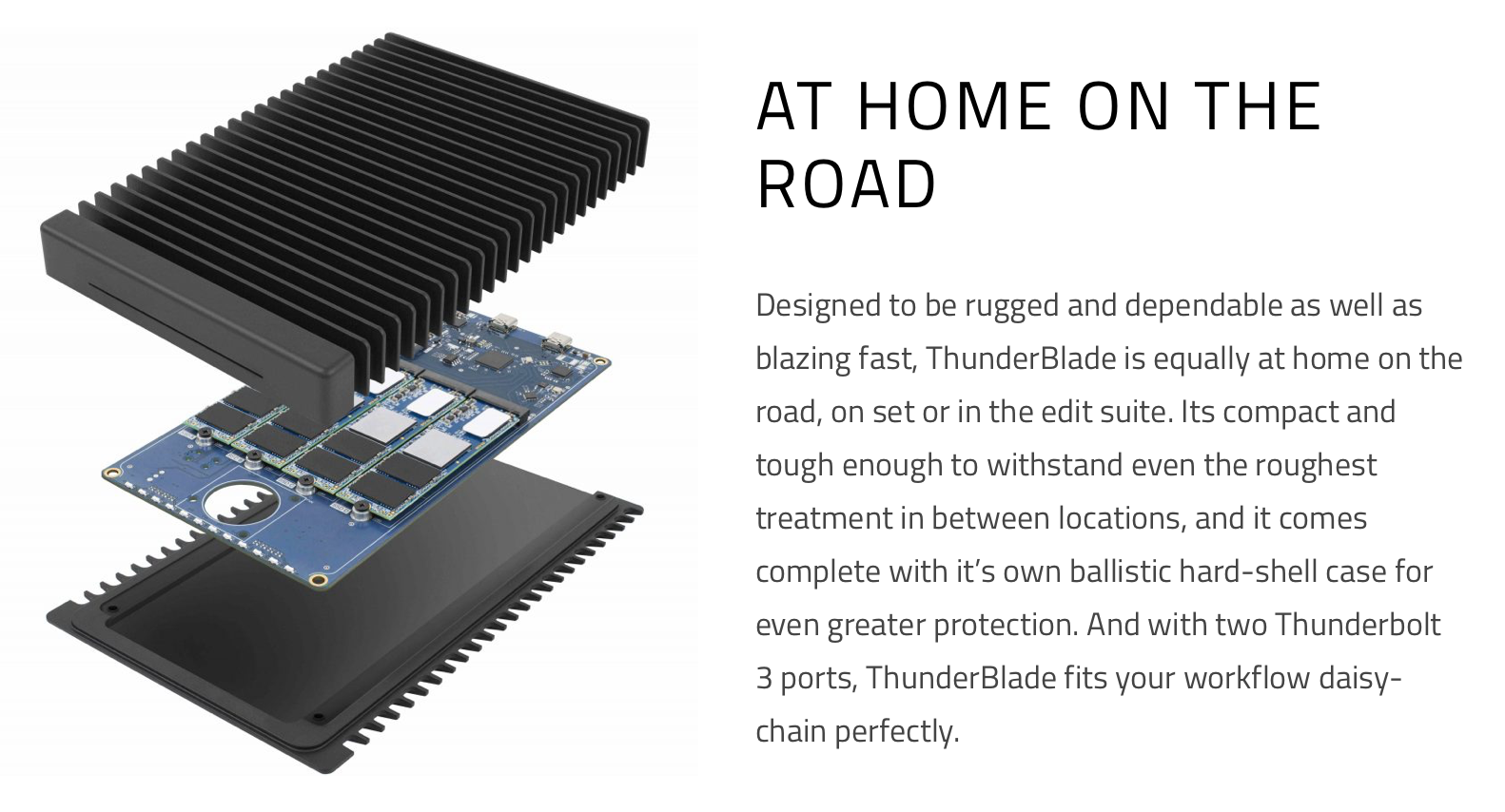
I’ve been using the OWC Thunderbolt 2 Dock for a while and don’t know what I’d do without it – but now they have the Thunderbolt 3 version, the NEED FOR SPEED is strong!
All the ports you’d need and expect in a powered dock that comes in both Mac (with FW800 port) and a Windows version as shown above. But – now includes a high-powered USB3 port and an SD card media reader.
This is the first year we’re seeing a few of these Thunderbolt 3 expansion boxes hit the show floor and I’m excited to test the Mercury Helios FX out with the AMD Radeon Pro SSG and benchmark some performance tests on both Mac & Win hardware.
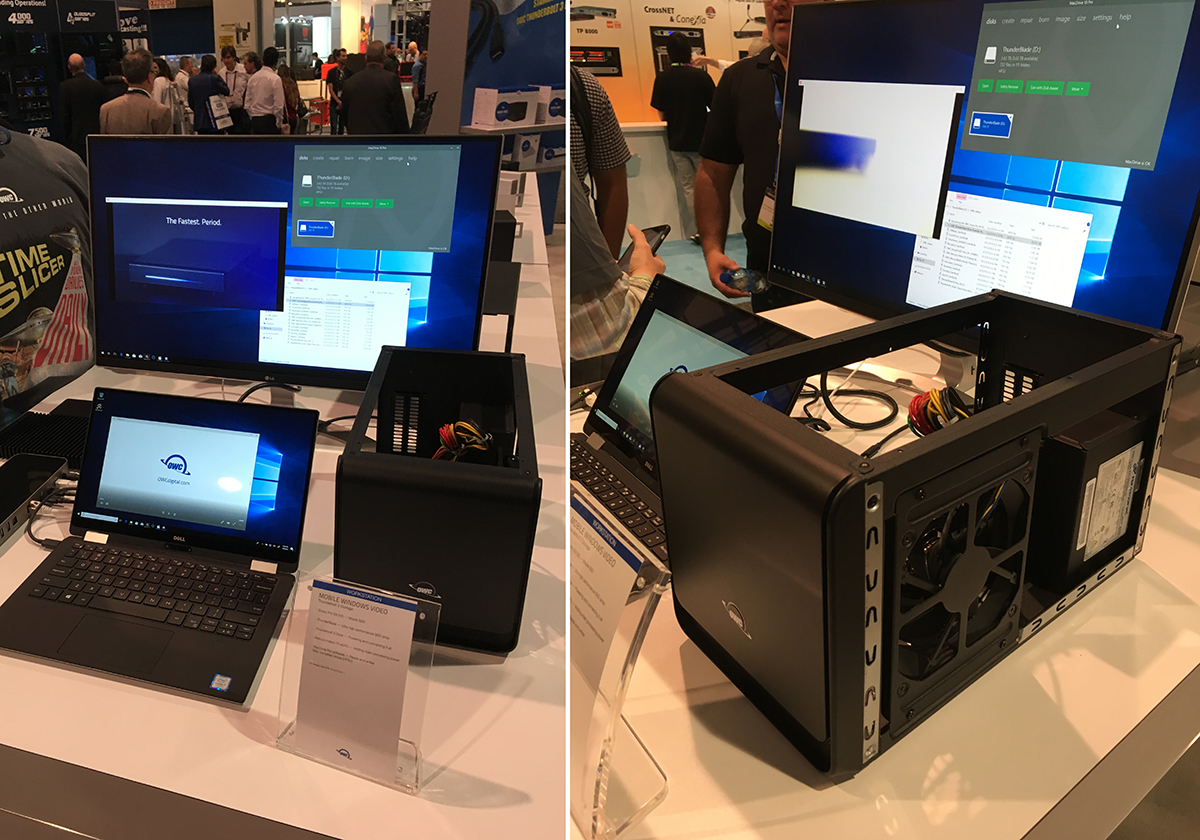
I should be testing this with the AMD Radeon Pro this summer as well. Stay tuned for results here on PVC…
Akitio
Akitio isn’t a household name just yet, but give them time! I’ve been testing some of their hardware for the past couple years and am impressed with their performance and build quality.
Akitio’s new Thunder 3 RAID Station is a hardware RAID controller that features tool-less chassis removal and installation of dual 2.5″ and 3.5″ drives, plus a second USB-C and Display port and up to 74W of power at the PCIe 16 slot.
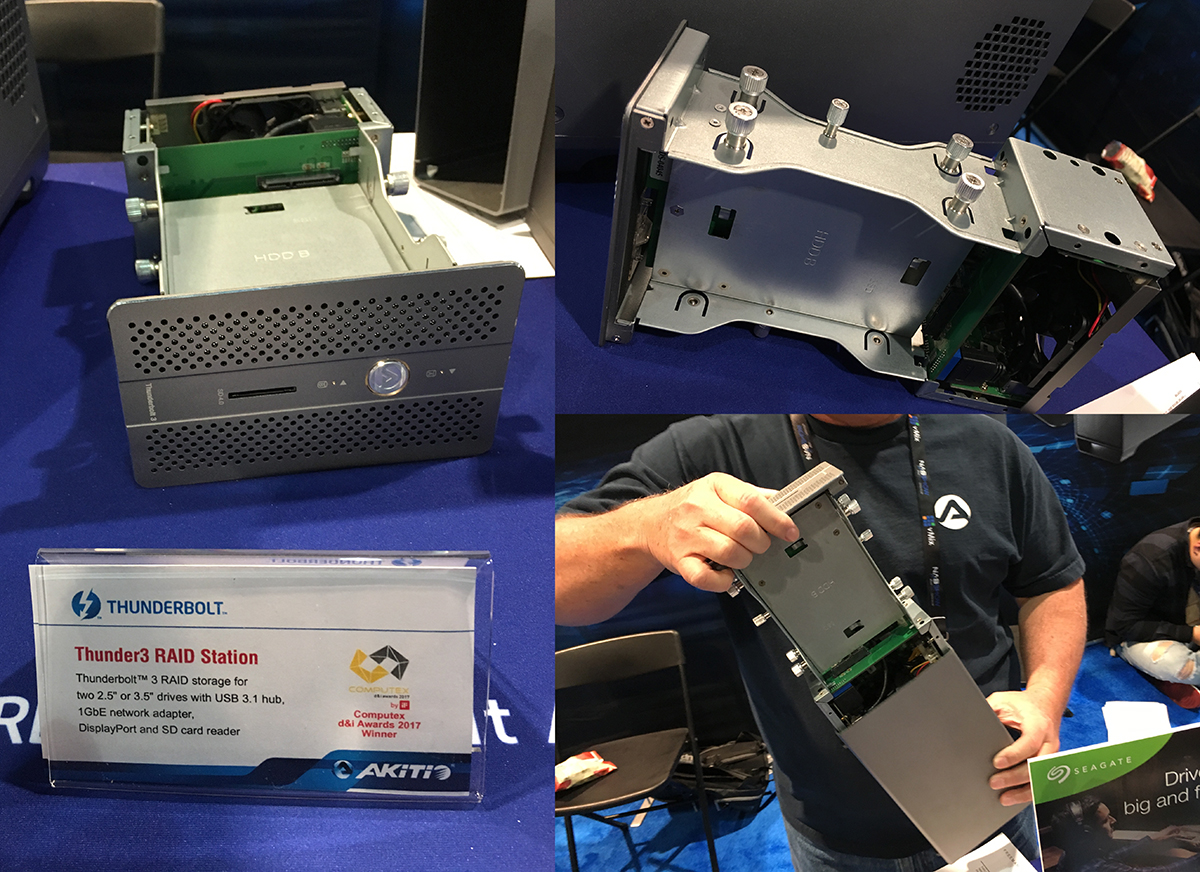
Features:
- Thunderbolt 3 for lightning fast transfer speeds up to 40 Gbps
- Second Thunderbolt 3 port supports Thunderbolt 3 (40 Gbps), USB 3.1 (10 Gbps), and DisplayPort devices
- Power delivery provides up to 27W of power to recharge compatible laptops
- Two USB 3.1 Gen 1 host ports with Type-A connectors for older USB devices
- 1 Gigabit Ethernet port supporting auto-negotiation for 1G, 100M, 10M
- Hardware RAID controller (RAID 0, RAID 1, SPAN, Non-RAID)
- Tool-less drive installation for 2.5-inch and 3.5-inch drives
- Cooling fan with power switch for noiseless operation
- Dedicated DisplayPort for additional 4K monitor
- Built-in SD card reader
The new Akitio Node Pro Thunderbolt 3 PCIe Expansion Chassis
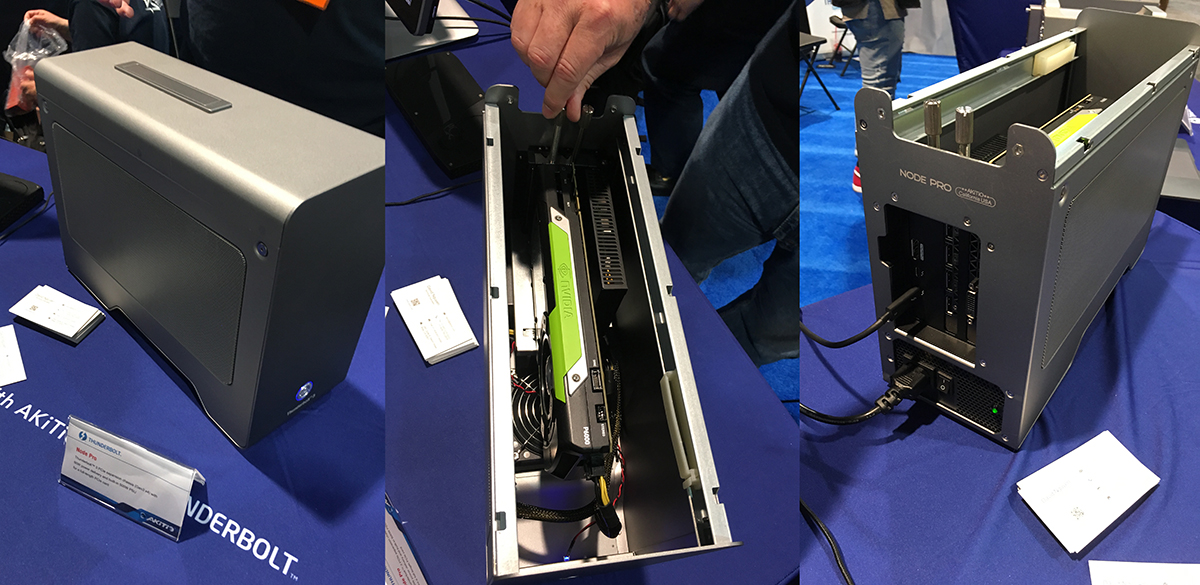
The Node Pro provides an additional PCIe slot for Thunderbolt 3 computers (e.g. laptop computers) where installing an internal expansion card is not an option and for systems where there is not enough space for more PCIe cards. The Thunderbolt 3 (USB-C) connection not only makes adding an external PCIe card easy but it also allows you to take the device with you to use on location and move it from one system to another. Installing and replacing the PCIe card is a simple matter of removing a few thumb screws and does not require any tools.
Features:
- Thunderbolt™ 3 for lightning fast transfer speeds up to 40 Gbps
- Dedicated DisplayPort for additional monitor to expand the workspace
- 2nd Thunderbolt port supports Thunderbolt 3, USB 3.1, and DisplayPort devices
- USB power delivery provides 60W of power to recharge compatible laptops
- Built-in 500W SFX power supply with an extra pair of 8-pin PCIe power connectors
- 1 PCIe (x16) slot supporting full-length, full-height, double-width cards
- 4 lane PCI Express 3.0 compliant interface
- Wire mesh panel to dissipate heat from cards with on-board fans
- Retractable carry handle to easily transport the device
- No tools required for installation of PCIe card
Look for reviews on both of these products this summer here on PVC!
Adobe CC 2018 Video Apps
While Adobe released their latest updates to the Adobe CC collection just prior to NAB, it’s definitely worth noting what a great update this was for their video tools! Some real editing time savers such as Color Matching and Audio Ducking will help make short work of your multi-cam video productions on a tight schedule. Some great time-saving (and frustration-saving) features popped-up in After Effects CC, like auto-centering anchor points in Shape Layers, import spreadsheets for data-driven animated graphics and the new advanced Puppet Tool refinements to create better animations. Audition also got some attention with the ability to import Premiere Pro sequences and the new Clip Spotting feature will greatly enhance the most-often-ignored aspect of good video production: Audio.
https://youtu.be/F3nwn1Zq4kE
Here’s a YouTube playlist that outlines most of the best new features added to Adobe CC 2018 this year!
If you want to dig deeper to discover what features have specifically been added to Adobe Premiere Pro, then check out this page: https://www.adobe.com/products/premiere.html
Wacom
I got to spend a great deal of quality time with the Wacom crew this year and reconnect with some old friends there. Some of the advancements coming out in the near future are going to be spectacular to say the least. But I was most impressed with how far they’ve come with their Cintiq Pro and MobileStudio Pro series!
They’ve modified their pen technology to be more efficient in eliminating the lag time by about 75%, while using a higher-quality (and much thinner) etched glass on the surfaces delivers a more direct feel and better parallax from the operator’s view.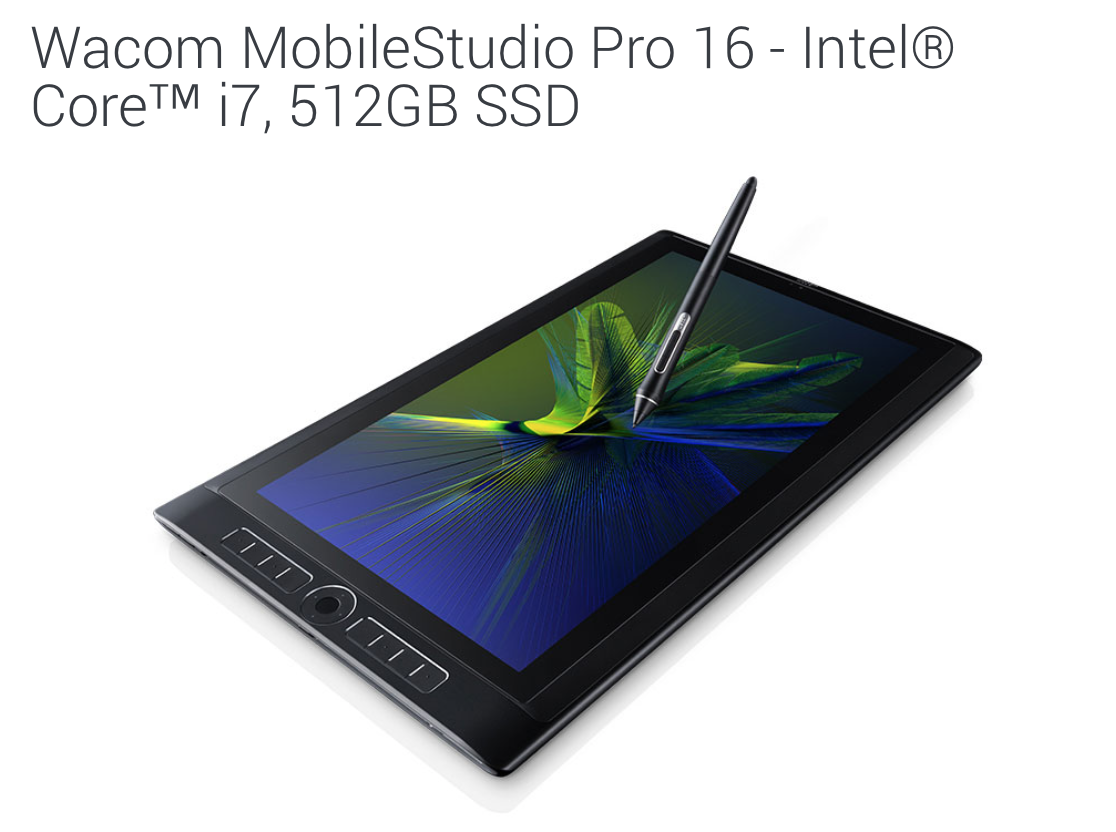
The MobileStudio Pro 16 lets you take your Cintiq anywhere with you – because it has a built-in computer. With the optional accessories, you could virtually have a portable digital artist studio in your pack running Windows 10 Pro on either a core i5 or core i7 processor and up to 512GB SSD, 16GB RAM and an NVIDIA® Quadro® M1000M 4GB GDDR5 graphics card onboard. It also features a MicroSD card slot making it easy to transfer files from your camera and quickly make edits on the fly. The USB-C connectivity also make it easy to connect to your PC or Mac and run as a regular Cintiq if needed.
I will be testing a MobileStudio Pro soon and will give a full write-up here on PVC, so stay tuned!
cineSync
Also running demos in the Wacom booth this year was a software production review product that was truly impressive called cineSync by Cospective.
Unlike other streaming video review services, cineSync actually has both parties run the video off their local drives and merely syncs the playback and commenting data over the streaming network – allowing both parties 100% quality playback in real time. No skipping or lag even on slow internet connections. Both parties can be the presenter and make comments, draw and highlight, add text, etc. right on the frame of the video which makes it visually clear what actions or edits need to be made. The ability to have these kind of reviews in person are tremendous enough, but to be able to do it remotely in real-time is huge.
I can see cineSync working for all kinds of film and video productions on any scale, as currently, we send off client proofs and wait for feedback either in emails, phone or screen grabs hastily marked-up in a PDF – often leaving room for unclear instructions or comments.
I’m hoping to review cineSync and run it through its paces in some real-world productions this summer. Stay tuned for my results here on PVC.
DaVinci Resolve 15
As announced at the Blackmagic press conference before the show opened on Monday am, DaVinci Resolve 15 now includes full Fusion motion graphics. The Fusion page gives you a complete 3D workspace with over 250 tools for compositing, vector paint, keying, rotoscoping, text animation, tracking, stabilization, particles and more. With new Apple Metal and CUDA GPU processing, the Fusion page is faster than ever. Fairlight audio gets a massive upgrade with new ADR tools, audio normalization, 3D panners, audio and video scrollers, a sound library database, and built in cross platform plug-ins such as reverb, hum removal, vocal channel and de-esser.
Here is the recorded segment from Grant Petty’s Press Conference on Monday am:
https://youtu.be/eLXtBOVWODI
There are also dozens of new features and improvements that editors and colorists have asked for. These include a new LUT browser, shared grades, multiple playheads, Super Scale HD to 8K up-rezzing, stacked timelines, on-screen annotations, subtitle and closed captioning tools, better keyboard customization, new title templates and much more.
I’ve yet to crack the seal on our DaVinci Resolve studio that came with the URSA Mini 4.6K but I’m really tempted to get it out, update it and give it a spin!
AI, VR/AR
Digital Anarchy (AI)
My friend and colleague Jim Tierney from Digital Anarchy (awesome plug-ins for Adobe CC video and imaging apps) has been busy again with his latest AI plug-in called Transcriptive, a video transcribing tool that works inside of Adobe Premiere Pro to help you intelligently search and identify words and phrases as easy as doing a Google search.
Jim was on an AI (Artificial Intelligence) panel on the main NAB Show live broadcast stage talking about the future of AI as a useful tool.
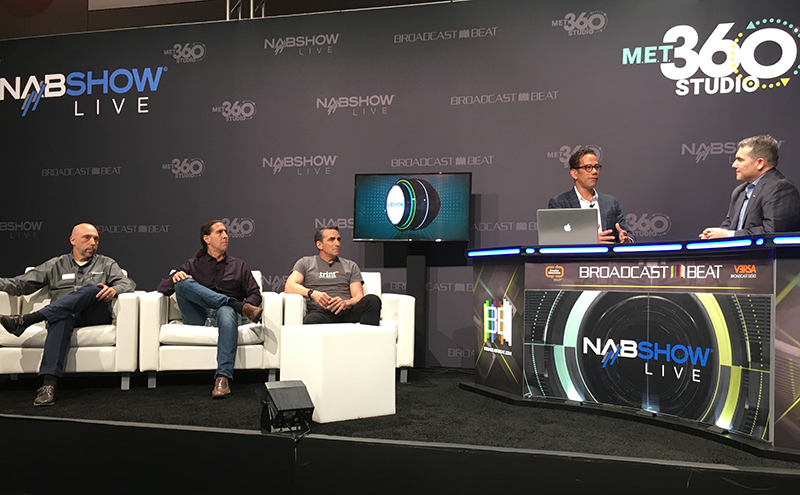
Check out this video that gives an overview of how Transcriptive works:
https://youtu.be/5zUs6EFtHgg
I will be testing Transcriptive in some real-world video productions with various accents and sound conditions and will be posting my review here on ProVideo in the near future.
VUZE+ (VR)
One of the things I was challenged to explore was a good stereo (3D) 360 VR camera. Doing some research before attending the show, I really narrowed my search down to two options: Insta 360 Pro and the VUZE+ Camera.
I’m a big fan of stenography since I was a child, going through boxes of stereo card from my grandmother’s Stereoptican (Google it) and of course I grew up in the age of the ViewMaster. I’ve even built my own stereo 35mm film camera with 2 synched Canon EOS Rebel cameras many years ago and it still works today!
The more I looked into the Insta 360 Pro the more it bothered me how it created the 3D Stereo effect in playback. Sure, it’s expensive and shoots a proposed 8K 360, but after using the GoPro Fusion for a couple months (see video at the end of this report) if you’re not stitching and reframing you’re really not gaining that much.
What really impressed me with the VUZE+ Camera was the fact they took the 3D stereo shot seriously. At NAB, I spoke with Shahar Bin-Nun CEO of Human Eyes in their VUZE booth and we geeked about the technology and engineering of the VUZE+ cam.
It’s actually 4K for each eye in stereo and the width set for the camera’s lenses is closest for the focal length to the human eye (approximately 2.48 inches), so you won’t get a false depth queue from an improper parallax of the convergence of the left/right eye at the focal point. (math stuff)
https://youtu.be/yRsaC8NZfco
Their software will extract the correct imagery and allow you to edit either in the software or stack the Left/Right eyes for editing in After Effects.
I will be testing the VUZE+ and doing a full breakdown of the workflow and editing process in Adobe After Effects CC soon, so again… STAY TUNED!
SeekXR (AR)
As one of the few listed developers of AR (Augmented Reality) at NAB this year, the guys at SeekºXR (seekxr.com) were in a startup pavilion in the North Hall but I sought them out and had a great talk with them at the show.
Seek is the world’s first and biggest augmented reality community. We empower creators to easily share and engage with their audience. Our goal is to create a central location where anyone can find, create, and explore the infinite possibilities of augmented reality.
Okay – so who ARE these guys and what do they do?
Speaking directly with the founding members of this startup at their booth, they want to be the “YouTube of AR”. Which if you download their app in the iTunes App store (free), you’ll see what it does with some of the examples and uploads by a handful of subscribers.
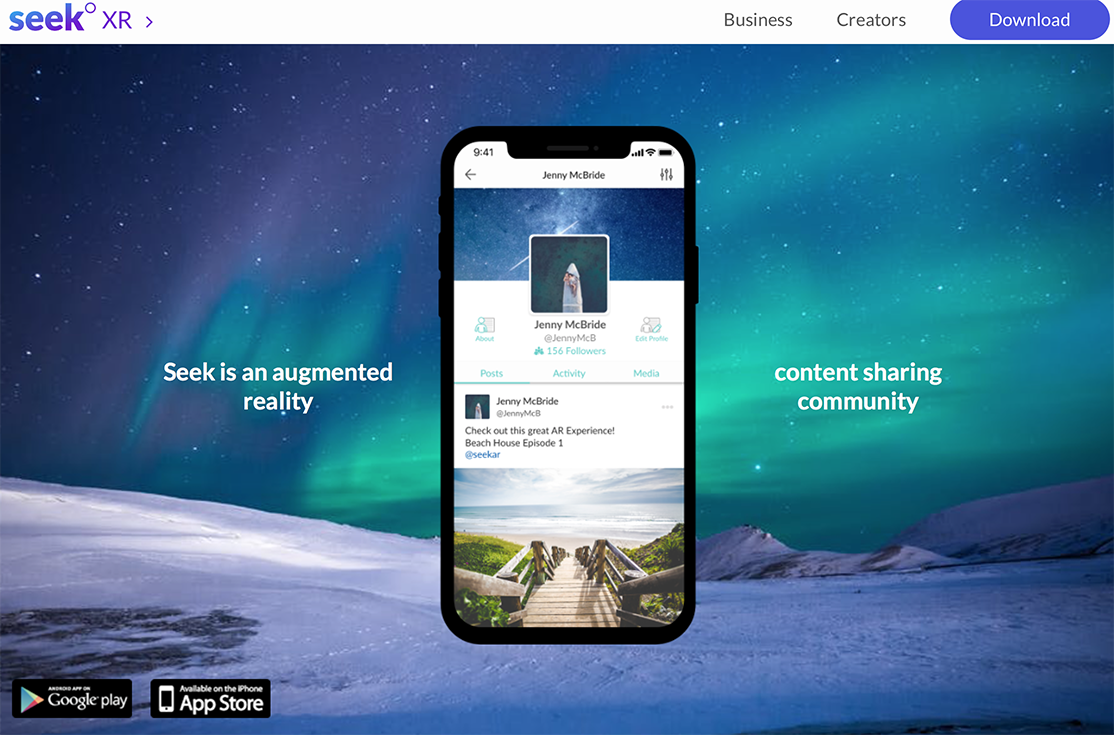
But seeing some of the earliest test 3D uploads I can totally see where this can go in the near future…
For one thing, it uses the smartphone’s camera and gyroscope to scale the objects to keep them in proper position and scale without the need for a printed reference sheet. However, this is still in the development phase and so far most of the examples are too crude and inaccurate to demonstrate uses for our scientific labs and marketing groups. I WILL be keeping an eye on these guys and see if they can out-perform their funding rounds!
Misc Cool Production Stuff:
ARwall demo (AMD)
Probably one of the coolest experimental demos I saw this year was this at the AMD booth for a projects called ARwall. An experimental project to replace green screen in a shoot by utilizing a large UHD OLED screen wall that displays Live 3D rendered sets that are view/position controlled by a sensor that mounts to the camera. This allows the camera to have a virtual extension of the set in 3D (like a FPS game) but in an extremely lifelike realtime rendered world. Of course with all that lighting, texture mapping and environmental effects, this takes a massive amount of rendering power – but with the help of AMD’s graphics processor cards they were able to produce some pretty impressive results in their demo short.
I was so engrossed by the technology and the demo that I didn’t think to shoot any video clips until the Q&A with the director/tech who is shown holding the device in the background while it’s following his motions.
The question I raised was “How does the talent deal with all the motion in front/around them while they’re on-set and acting? Do they get dizzy/nauseous?” – and indeed as suspected, it’s tough for anyone who isn’t the POV point person (camera op) to endure for too long without adverse symptoms, but it’s still a pretty brilliant approach to the old rear-screen projection techniques used back in the 30s and 40s. Looking forward to where this is headed.
Padcaster
My buddy Josh Apter started working not he original Padcaster years ago and I’ve used every model he’s released since day one (and still use them!) – it’s a great versatile product! So enter the Padcaster Verse (play on the word “Versatile) which is really aimed at the podcaster and YouTube “Vlogger” producer.
Some key features:
- Rugged frame ensures your iPhone, Android or small tablet stays safe .
- Combo mini-tripod, grip & charger steadies every shot and keeps the cameras rolling.
- Mini-mic cuts through the noise.
- Flexible G-POD wraps around anything so you can get any shot.
- 13 on-frame threads secure lights and other accessories.
- Seamless integration with pro-filmmaking and livestreaming apps.
They also have an attachment for a small prompter using your smartphone which is pretty cool. I got a review unit to test out and will be posting my results/uses soon on PVC.
In the meantime, go check out their videos and info on their website.
Sony Bullet-time Cams
I went through the Sony booth to see their new 8K video wall and ran into this crazy contraption. The new Sony RX0 (Sony’s version of the GoPro) was on display in different usage configurations including their bullet-time racks. This one however was mounted on something like a Steadicam vest where the operator can run around a character of the center of the action – which I can’t wait to see some resulting shots from this thing!
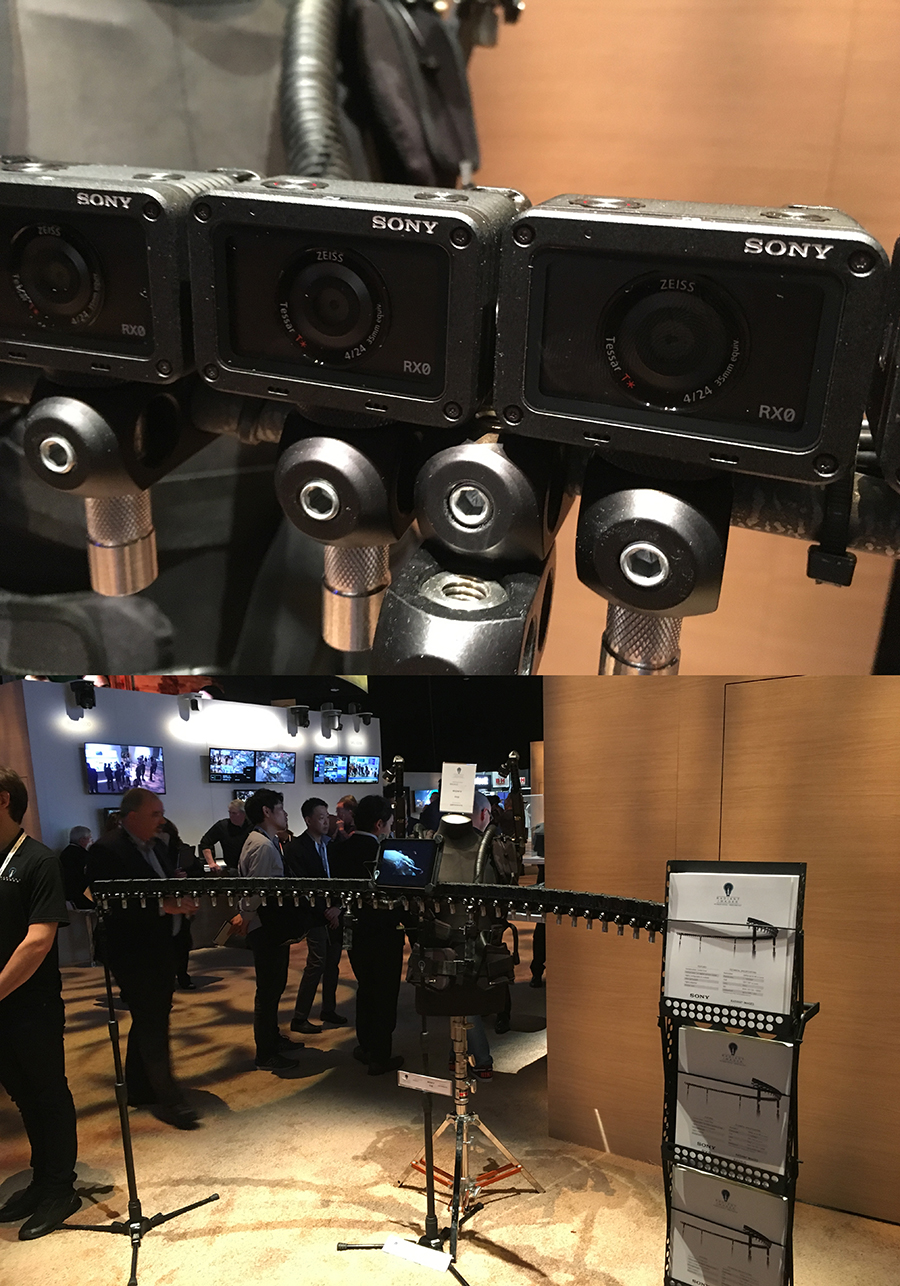
ProCyc (green screen materials)
ProCyc is the leader in cycling wall construction for studios all over the globe and has one of the best portable options I’ve seen yet. Instead of fabric, the PC160 portable green screen kit features their Pro Matte IV plastic material is washable and remains flat and wrinkle-free when set-up. Resistant to scuff marks from shoes and other objects – should make it last for years of use.
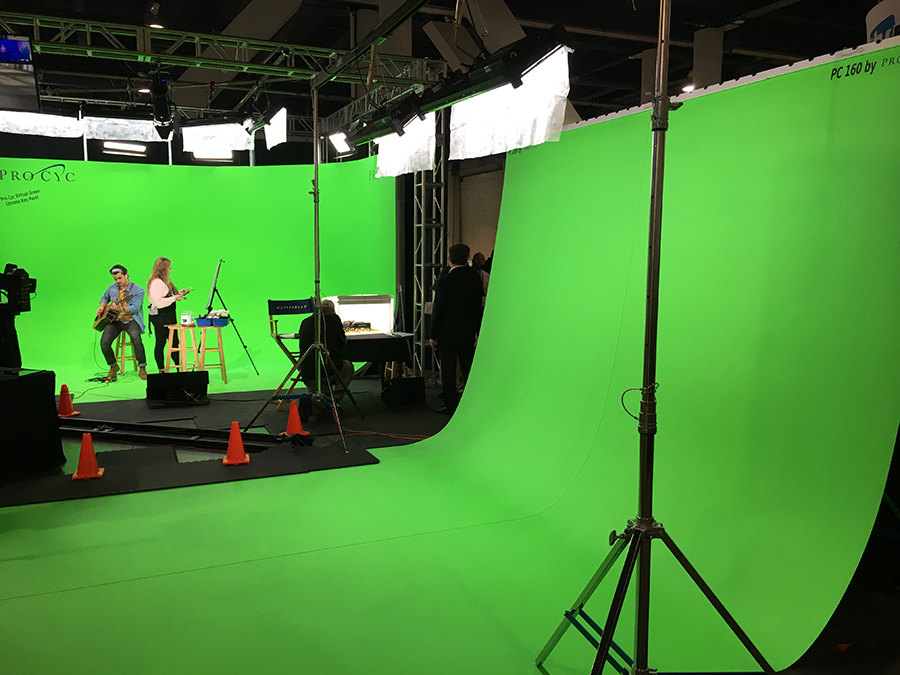
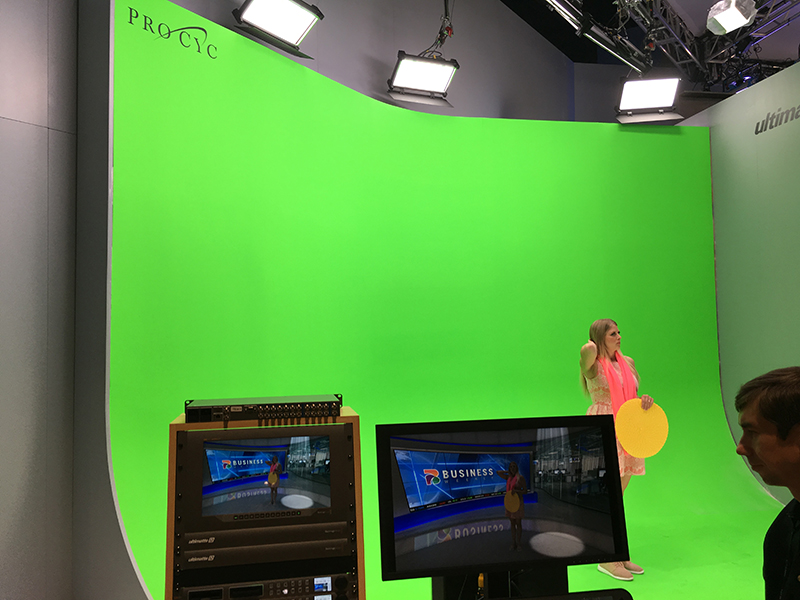
The ProCyc wall constructed in the Blackmagic Ultimatte booth uses 3ft cyc curves and a 45º back wall for optimum coverage. You can also use the ProCyc plastic material on the floors and blend in with the paint to match at the seams, but there will be slight seams so paint still seems to be the best option for a built-in studio.
Overview
Overall, I came away from NAB Show 2018 with a lot of great info and new products to test and review on. Will be examining a lot of materials to see how best any of these productions tools will work but in our corporate MarCom media workflow this coming year. And watch for the product reviews forthcoming this summer!
So here’s a video shot entirely with the GoPro Fusion 360 cam as I went through the show floor over 3 days – and of course, a little networking time in the evenings with my colleagues from Tiffen, Adobe and Wacom.
https://youtu.be/O0ucFu8tBYw
Cheers! Jeff

Filmtools
Filmmakers go-to destination for pre-production, production & post production equipment!
Shop Now